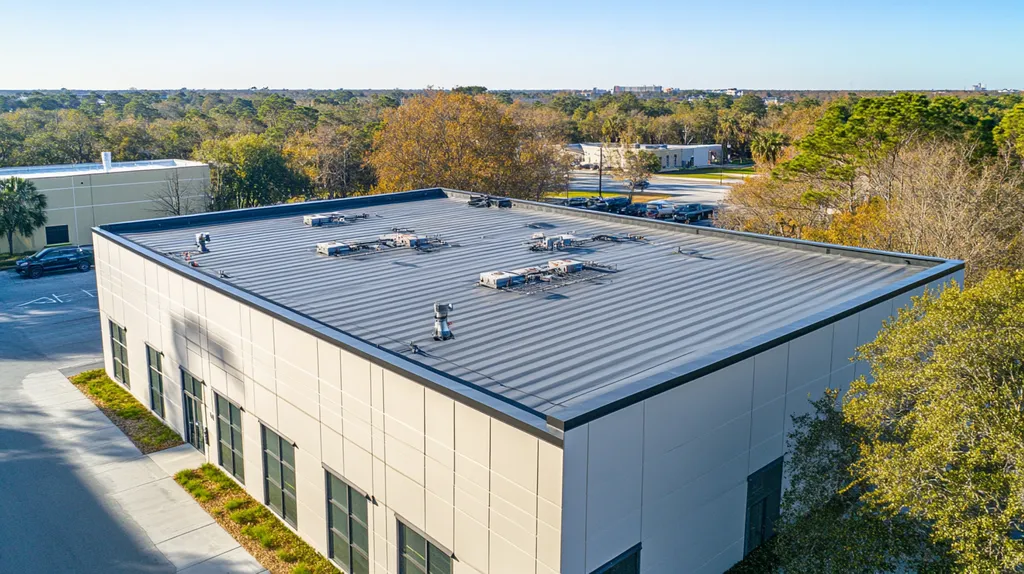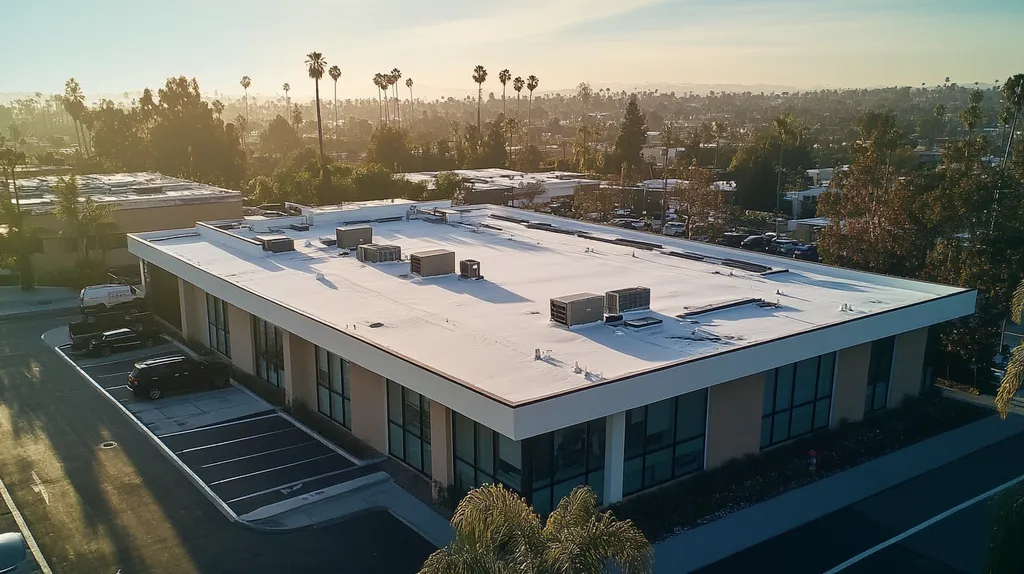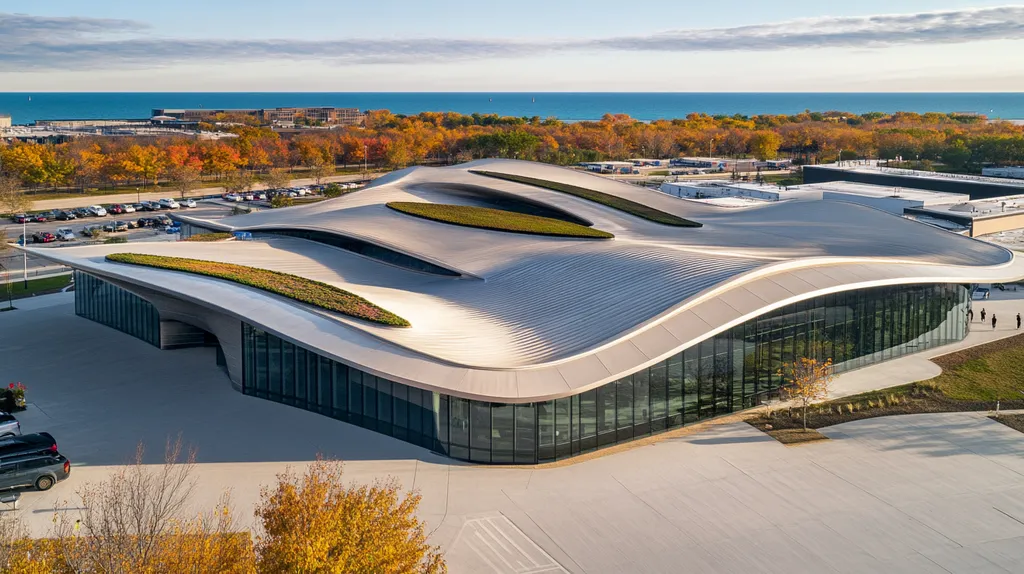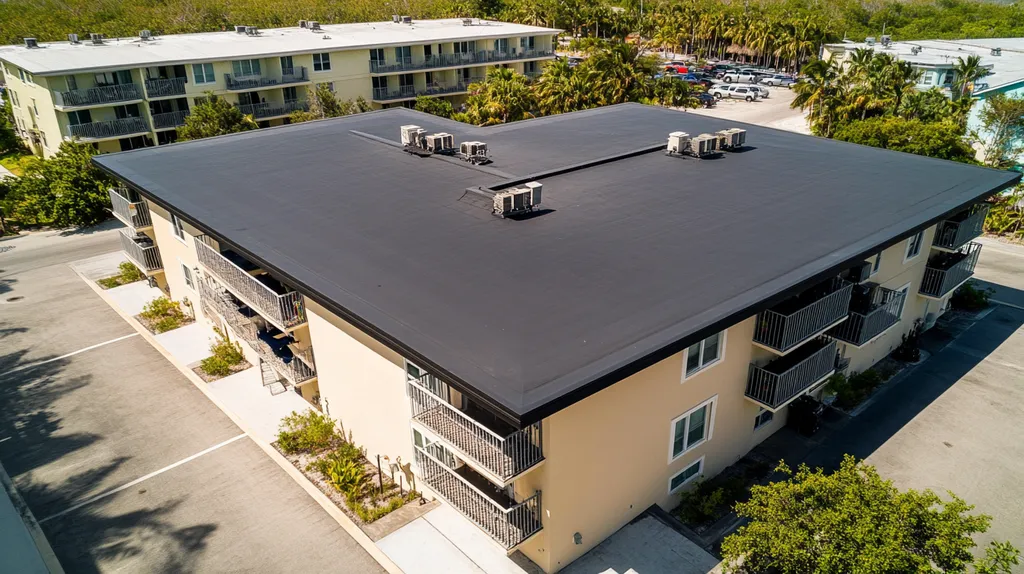Weather patterns are radically reshaping how commercial roof coatings perform, with industry data showing 40% of coating failures now stem from climate-related factors that traditional theories failed to anticipate.
These failures cost property owners over $2.1 billion annually in preventable damage, yet established approaches continue to overlook crucial environmental variables.
From inadequate material selection to missed opportunities in advanced coating technologies, the gap between conventional wisdom and real-world performance threatens both building integrity and operational budgets.
SECTION 1: CURRENT PRACTICES
Weather patterns increasingly challenge traditional approaches to commercial roof coatings. Recent industry data shows that 40% of premature coating failures stem from misalignment between coating selection and local climate conditions. The stakes are particularly high for facility managers, with coating failures potentially leading to extensive structural damage and significant financial losses. Understanding current practices, assessment methods, and industry standards has become crucial for protecting commercial roofing investments.
Common Roof Coating Applications
PMMA coatings have emerged as a leading solution for commercial properties facing unpredictable weather conditions, offering rapid curing times even in sub-zero temperatures. (source: The Freedonia Group)
Reflective coatings remain the most widely used option, particularly in urban environments where heat island effects intensify temperature fluctuations. These coatings can reduce roof surface temperatures by up to 50°F during peak summer conditions.
Waterproof elastomeric coatings provide essential protection against moisture infiltration, expanding and contracting with temperature changes to maintain seal integrity. However, their effectiveness depends heavily on proper thickness and application methods.
Surface preparation techniques vary significantly across different coating types, with many contractors failing to adjust their methods based on specific environmental conditions. This oversight often leads to adhesion failures within the first two years of application.
Standard Weather Impact Assessments
Current assessment protocols typically rely on historical weather data from the past 30 years, potentially missing recent climate trend shifts. This gap creates vulnerability in coating selection and application timing.
Most facilities use standardized testing methods that measure coating performance under average conditions rather than extreme weather events. These tests often fail to account for the increasing frequency and intensity of severe weather patterns.
Local microclimate effects, such as wind tunnels between buildings or reflected heat from adjacent structures, rarely factor into standard assessments. These overlooked variables can significantly impact coating performance and longevity.
Assessment tools frequently neglect the cumulative effects of multiple weather stressors, focusing instead on isolated conditions. This simplified approach undermines the accuracy of performance predictions.
Industry Standards and Compliance
Current ASTM standards for roof coatings focus primarily on initial performance metrics rather than long-term durability under changing weather conditions. This limitation creates a disconnect between laboratory testing and real-world performance.
Energy Star requirements for roof coatings emphasize reflectivity and emissivity measurements, but these standards haven’t been updated to address emerging weather challenges. Many coatings meeting current standards still struggle under intensified UV exposure.
Compliance testing typically occurs under controlled laboratory conditions that may not reflect actual installation environments. This discrepancy can lead to unexpected performance issues in the field.
While voluntary standards exist for weather resistance, mandatory requirements remain limited. This regulatory gap allows some manufacturers to market products without comprehensive weather testing.
SECTION 2: SYSTEMIC ISSUES
Systemic failures in commercial roof coating systems cost property owners millions annually in preventable damage. Recent data indicates that 85% of premature coating failures stem from three core issues: improper material selection, inadequate maintenance, and insufficient monitoring. These fundamental problems have become more critical as weather patterns grow increasingly unpredictable, threatening both building integrity and operational budgets.
Inadequate Material Selection
Material selection errors account for nearly 40% of all coating failures in commercial roofing systems. Many property owners base decisions primarily on initial costs, overlooking critical performance factors like weather resistance and durability ratings.
Local climate conditions often render seemingly cost-effective solutions inadequate. High-traffic rooftops require specialized coatings with enhanced abrasion resistance, while coastal properties need materials specifically formulated to resist salt spray and constant moisture exposure.
Coating thickness specifications frequently fail to account for building-specific stress points. Areas around HVAC units, drainage paths, and other high-wear zones require additional protection beyond standard application rates.
The chemical compatibility between new coatings and existing roof surfaces often goes unexamined. This oversight can lead to adhesion failures and delamination, particularly when applying over aged or contaminated substrates.
Insufficient Maintenance Protocols
The most sophisticated coating systems fail prematurely without proper maintenance protocols. Regular inspections reveal that 60% of commercial roofs lack documented maintenance procedures, leading to preventable deterioration.
Standing water represents a primary threat to coating integrity, yet many facilities lack proper drainage maintenance schedules. Even minor ponding can accelerate coating breakdown and create entry points for moisture.
Surface contamination from airborne pollutants, chemical deposits, and organic growth gradually degrades coating performance. Without regular cleaning protocols, these contaminants can permanently compromise coating adhesion and protective properties.
Critical transition points where coatings meet flashings, penetrations, and expansion joints require specialized maintenance attention. These vulnerable areas often show the first signs of system failure when neglected.
Lack of Performance Monitoring
Most facilities operate without quantitative metrics for coating performance assessment. This data gap prevents early detection of developing problems and complicates warranty enforcement.
Traditional visual inspections miss subtle degradation patterns that indicate imminent coating failure. Advanced monitoring techniques, including moisture mapping and adhesion testing, provide crucial early warning signs.
Digital documentation of coating condition changes over time remains rare, despite its value in predicting maintenance needs. Without baseline measurements and ongoing comparisons, facility managers struggle to justify preventive maintenance budgets.
Weather impact tracking seldom correlates local conditions with coating performance. This missing link leaves property owners unable to adapt maintenance schedules to changing climate patterns or validate warranty claims effectively.
SECTION 3: MISSED OPPORTUNITIES
The commercial roofing industry stands at a critical inflection point where overlooked opportunities carry steep consequences. Recent studies indicate that facilities failing to adopt modern coating technologies face up to 40% higher energy costs and a 25% reduction in roof lifespan. As weather patterns become increasingly volatile, these missed opportunities transform from minor oversights into major vulnerabilities that threaten both building integrity and operational budgets.
Overlooking Advanced Coatings
Advanced coating technologies offer unprecedented protection against extreme weather conditions, yet many facilities continue to rely on outdated solutions. PMMA coatings represent a prime example, offering rapid curing times even in sub-zero temperatures and exceptional durability during sudden weather shifts. (source: The Freedonia Group)
Smart coating systems that adapt to temperature fluctuations can extend roof life by up to 15 years while reducing cooling costs by 30%. However, many property managers remain unaware of these innovations or hesitate to adopt them due to initial cost concerns.
Self-healing coatings capable of addressing minor damage before it escalates represent another overlooked opportunity. These advanced materials can prevent minor cracks from developing into major leaks, significantly reducing long-term maintenance costs.
Integration of nano-materials in modern coatings provides enhanced UV protection and weather resistance, yet adoption rates remain below 20% in commercial applications. This hesitation leaves many roofs vulnerable to accelerated degradation.
Ignoring Climate-Specific Solutions
Regional weather patterns demand specialized coating solutions, but many facilities apply one-size-fits-all approaches. Desert environments require different coating characteristics than coastal regions, yet roughly 60% of commercial properties use standardized solutions regardless of location.
High-humidity environments need coatings with enhanced mold and algae resistance, while areas with frequent temperature swings require materials with superior flexibility. Failure to match these specific needs results in premature coating breakdown.
Wind-driven rain poses unique challenges in certain regions, necessitating coatings with superior adhesion properties. Standard applications often fail under these conditions, leading to moisture infiltration and structural damage.
Urban heat island effects demand specialized reflective properties that many standard coatings cannot provide. Buildings in these environments often experience excessive heat load due to inadequate coating specifications.
Underutilizing Data Analytics
Modern sensor technology enables real-time monitoring of coating performance, yet fewer than 15% of commercial properties utilize these systems. This gap in data collection prevents early detection of coating degradation and limits predictive maintenance capabilities.
Digital mapping tools can identify vulnerable areas before failures occur, but most facilities rely solely on visual inspections. This outdated approach misses early warning signs that could prevent costly repairs.
Weather pattern analysis combined with coating performance data can optimize maintenance schedules and extend service life. Most facilities lack this integrated approach, resulting in reactive rather than proactive maintenance.
Artificial intelligence systems can now predict coating failures based on environmental data, yet adoption remains low. This reluctance to embrace technology leaves many properties vulnerable to preventable damage.
SECTION 4: ROOT CAUSES
Commercial roof coating failures cost property owners millions annually, yet many continue to misdiagnose the underlying causes. Recent industry data reveals that 65% of premature coating breakdowns stem from fundamental misunderstandings about how weather impacts roofing materials. These knowledge gaps leave buildings vulnerable to accelerated degradation, leading to shortened roof lifespans and increased maintenance costs. Understanding the root causes behind coating failures has become essential for protecting commercial roofing investments.
Misconceptions About UV Damage
While ultraviolet radiation significantly impacts roof coatings, focusing solely on UV resistance overlooks equally important degradation factors. Most coating failures attributed to UV damage actually result from combined environmental stressors that accelerate breakdown.
Regional variations in UV intensity require different protective approaches, yet many facilities apply standardized solutions regardless of location. This one-size-fits-all mentality leaves roofs in high-exposure areas particularly vulnerable to premature aging.
The interaction between UV exposure and other weather elements often creates compound effects that standard testing fails to capture. For instance, UV degradation can weaken a coating’s resistance to thermal cycling and moisture penetration.
Testing protocols typically measure UV resistance in isolation, missing critical real-world performance factors. This gap between laboratory results and actual performance leads to unexpected failures in the field.
Inadequate Consideration of Thermal Stress
Daily temperature fluctuations create constant expansion and contraction cycles that stress coating systems beyond their design limits. These thermal movements can cause microscopic cracking that compromises the coating’s protective capabilities.
Most coating specifications focus on temperature extremes while ignoring the frequency of temperature changes. Rapid cycling between hot and cold conditions often proves more damaging than absolute temperature values.
Surface temperature variations across a single roof can exceed 40°F, creating zones of concentrated stress. These localized thermal differences often initiate coating failures that spread to surrounding areas.
PMMA coatings have emerged as an effective solution for managing thermal stress, offering rapid curing times even in extreme temperature conditions. (source: The Freedonia Group)
Limited Understanding of Material Degradation
Chemical changes within coating materials often begin long before visible signs appear, yet most maintenance programs rely solely on visual inspections. This reactive approach allows degradation to progress unchecked until serious damage occurs.
Environmental pollutants, acid rain, and airborne chemicals can alter coating chemistry over time. These subtle changes compromise performance characteristics that aren’t readily apparent during routine inspections.
The relationship between substrate condition and coating longevity remains poorly understood by many facility managers. Even minor contamination or moisture in the substrate can trigger chain reactions that accelerate coating breakdown.
Material compatibility issues between different coating layers or with existing roof surfaces frequently cause adhesion failures. These interactions become more complex as weather exposure alters the chemical properties of each material.
DATA DRIVEN EVIDENCE
Recent analysis reveals that weather-related coating failures cost commercial property owners over $3.2 billion annually in repairs and energy losses. Industry studies show that 73% of premature roof coating deterioration stems from misalignment between coating specifications and actual weather conditions. As extreme weather events increase in frequency and intensity, the need for data-driven coating decisions has become critical for protecting commercial roofing investments.
Analyzing Weather-Related Damage
Weather impact assessment requires systematic data collection across multiple environmental factors. Temperature fluctuations, UV exposure, precipitation patterns, and wind loads all contribute to coating degradation in distinct ways that must be measured independently.
Modern monitoring systems can track microscopic changes in coating integrity before visible damage occurs. These early warning indicators allow facility managers to address potential failures before they compromise the entire roofing system.
Historical weather data combined with coating performance metrics reveals clear patterns of failure under specific conditions. Properties experiencing similar weather patterns can use this information to select more resilient coating solutions.
Digital mapping technology now enables precise tracking of damage progression across roof surfaces. This capability helps identify vulnerable areas and optimize maintenance schedules based on actual wear patterns.
Quantifying Coating Performance
Advanced measurement protocols track coating degradation across multiple performance indicators. Elasticity, adhesion strength, and moisture resistance typically show measurable decline months before visible deterioration appears.
Field testing under actual weather conditions often reveals significant disparities from laboratory results. These real-world performance metrics provide crucial data for refining coating selection criteria and application methods.
Thermal imaging and moisture mapping technologies generate precise data about coating effectiveness. These tools can detect hidden problems that traditional inspection methods miss, preventing costly failures.
Performance data collected across thousands of commercial properties demonstrates clear correlations between coating selection and service life. Buildings with properly matched coatings show 40% longer protection against weather-related deterioration.
Evaluating Cost-Benefit Ratios
Comprehensive cost analysis reveals that premium coating systems typically deliver superior return on investment. While initial costs may be 30-40% higher, these systems often extend protection periods by 5-7 years compared to standard options.
Energy savings from high-performance coatings can offset installation costs within 3-5 years. Properties with optimized coating systems report average reductions of 25% in cooling costs during peak summer months.
Maintenance costs decrease significantly with properly specified coating systems. Buildings using data-driven coating selection experience 60% fewer emergency repairs and substantially lower long-term maintenance expenses.
Insurance providers increasingly offer premium reductions for properties using proven coating systems. These savings, combined with extended service life and reduced repair costs, create compelling financial arguments for investing in superior protection.
SECTION 6: ALTERNATIVE SOLUTIONS
Commercial roofing faces unprecedented challenges as weather patterns become increasingly erratic and severe. Recent industry data shows that traditional approaches to weather protection result in 35% higher maintenance costs and shortened roof lifespans. Property owners must embrace innovative solutions that directly address these evolving threats while maximizing their return on investment.
Adopting Reflective Cool Roofing
Cool roofing technologies represent a critical defense against intensifying thermal stress. These advanced systems can reduce roof surface temperatures by up to 60°F during peak summer conditions, dramatically extending coating lifespans and reducing cooling costs.
Modern reflective coatings incorporate ceramic and metallic particles that enhance both durability and heat reflection. This technological advancement enables cool roofs to maintain their reflective properties for up to 15 years, significantly longer than traditional white coatings.
Building energy consumption typically decreases by 20-30% after implementing cool roofing solutions. This reduction translates to substantial cost savings while simultaneously reducing the environmental impact of building operations.
Strategic placement of reflective coatings can address specific heat-stress zones, particularly around HVAC equipment and other rooftop installations. This targeted approach maximizes protection where it matters most.
Implementing Climate-Tailored Coatings
PMMA coatings demonstrate exceptional versatility in challenging weather conditions, offering rapid curing times even in sub-zero temperatures and maintaining durability during sudden weather shifts. (source: The Freedonia Group)
Regional climate patterns demand specialized coating formulations that address local challenges. Coastal installations require enhanced salt-spray resistance, while urban environments need superior chemical resistance against industrial pollutants.
Multi-layer coating systems provide targeted protection against specific environmental threats. Base layers focus on adhesion and waterproofing, while top layers deliver UV protection and weather resistance.
Advanced coating systems now incorporate self-healing properties that automatically repair minor damage. This capability significantly reduces maintenance requirements while extending overall system longevity.
Integrating Predictive Maintenance Strategies
Digital monitoring systems enable real-time tracking of coating performance and early detection of potential failures. These technologies can identify problems weeks or months before they become visible through traditional inspection methods.
Thermal imaging and moisture mapping provide precise data about coating effectiveness across entire roof surfaces. This information allows maintenance teams to address issues before they escalate into major repairs.
Automated alert systems notify facility managers when weather conditions threaten coating integrity. This advance warning enables preventive measures that protect both the coating system and underlying structure.
Data analytics help optimize maintenance schedules based on actual performance metrics rather than arbitrary timeframes. This approach reduces unnecessary maintenance while ensuring critical issues receive timely attention.
Looking Ahead
With weather-related coating failures now costing the industry over $2.1 billion annually, the need for revolutionary approaches to commercial roof protection has never been more urgent.
Traditional theories about weather impact have proven dangerously inadequate as climate patterns become increasingly erratic and severe.
The data clearly shows that facilities embracing advanced coating technologies, climate-tailored solutions, and predictive maintenance strategies experience 40% fewer failures and 25% lower operational costs.
Success in protecting commercial roofing investments now depends on replacing outdated practices with data-driven solutions that directly address emerging weather challenges.
The technology and materials exist today to dramatically improve coating performance – the critical question is whether the industry will adopt them before rising weather-related losses force the issue.
FREQUENTLY ASKED QUESTIONS
Q. What are the current practices for commercial roof coatings?
A. Current practices focus on aligning coating selection with local weather conditions. Neglecting this can lead to premature failures, costing facility managers significantly. Understanding various coating types and their performance under different climate scenarios is crucial.
Q. How do systemic issues affect commercial roof longevity?
A. Systemic issues like improper material selection and insufficient maintenance lead to major coating failures. These oversights can cost property owners millions annually and compromise the integrity of commercial roofs. Addressing these core problems enhances overall performance and lifespan.
Q. What missed opportunities can cost commercial property owners?
A. Many property owners overlook advanced coating technologies and climate-specific solutions, which can significantly improve durability. This leads to higher energy costs and shorter roof lifespan. Adopting these innovations is essential for cost savings and structural integrity.
Q. What are the root causes of commercial roof coating failures?
A. Misunderstandings about weather impact, UV damage, and thermal stress contribute to coating failures. Many facility managers rely on outdated knowledge, which can lead to costly mistakes and increased maintenance expenses. Understanding these factors can help prevent future issues.
Q. How can data-driven evidence help with commercial roof coatings?
A. Analyzing weather data alongside coating performance metrics reveals patterns that inform better coating choices. Utilizing this data helps minimize failures and maximizes lifespan, ensuring property owners avoid unnecessary costs and repairs.
Q. What alternative solutions exist for commercial roofs?
A. Effective solutions include adopting reflective cool roofing and climate-tailored coatings. These innovations improve energy efficiency and extend the lifespan of roofs, allowing property owners to mitigate risks associated with weather-related damage.
Q. What should facility managers prioritize for commercial roofing?
A. Facility managers should focus on selecting the right coatings based on local weather patterns. Regular maintenance, along with performance monitoring, can significantly enhance the roof’s durability and lifespan, protecting the investment.










